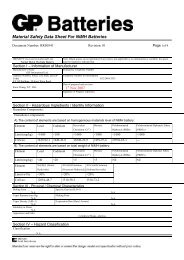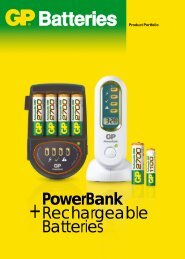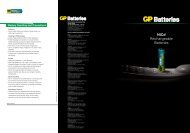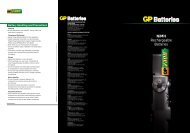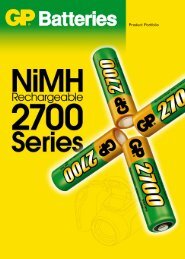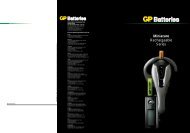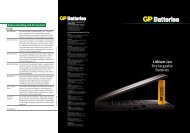7 Proper Use & Handling7.1Restriction on UsageKnowledge of battery maintenance is crucial toa working battery, helping to provide a longerperiod of operation. On the other hand, improperbattery handling or maintenance may lead tounnecessary battery defects or problems, suchas electrolyte leakage or cell bulging. In order toget the most out of using GP NiMH rechargeablecells, special care in the following areas shouldbe considered:7.1.1 Charging / discharging currentFor fast charging GP NiMH batteries, the currentrate should be 0.5C to 1C. Trickle charging, whichis common in various applications (such asmemory backup), requires a current chargingrange of 0.05C to 0.1C to maintain the long-termstandby power of the battery. In addition, GPNiMH batteries can be trickle-charged at 0.1Ccontinuously for one year without leakage orexplosions. Charging current rates higher than1C are generally not recommended. Howevercharging with pulses higher than 1C is notuncommon in some applications. Please contactauthorised GP personnel to determine theapplicability of special charging schemes notmentioned in GP product specifications.Special attention should be paid to the chargetermination method, which is a critical elementin providing an optimised cycle life, yet one whichis easily overlooked. Several charging cut-offmechanisms with related parameters can beconsidered:Negative delta voltage:dT/dt:Temperature control:0-5mV0.8°C/min (0.5C to 0.9C)0.8-1°C/min (1C)45-50°CTimer control: 105%These charging cut-off mechanisms can beincorporated into the application – either togetheror individually, with the choice of methoddepending largely on the charging profile of theapplication. To avoid unnecessary batteryproblems, which might look like quality issues,please contact authorized GP personnel forimplementing the appropriate charging cut-offmethod.A wide range of required discharge current rateswill be encountered in different applications, andGP has a variety of battery types for specialiseduse. Apart from the standard series for generalapplications, high temperature and high drainseries are specially designed for applications inhigh ambient temperatures and discharge currentrates respectively. The maximum dischargecurrent recommended for batteries of standardseries is generally 3C. However, there aresituations where higher currents of shorterduration are permissible.7.1.2 Reverse chargingReverse charging is one of the battery misusesthat can appear to be a battery defect. If thepositive and negative polarities are reversed whencharging, the battery might bulge due to internalgassing. Electrolyte leakage consequently resultsdue to venting at the safety valve, which leadsto a decrease in capacity. Caution has to beexercised to avoid such misuse.7.1.3 Parallel chargingParallel charging is generally not recommended,please consult authorized GP personnel forpossible exceptions to connecting the batteriesin parallel charging.7.1.4 Charging / discharging temperatureIt is important to understand how ambienttemperature affects the charging and dischargingof batteries, especially for obtaining maximumefficiency in conditions that exceed roomtemperature. GP recommends the followingtemperature range.Standard, high drain and high capacity series -cylindrical / prismatic / 9VStandard charge:Fast charge:0°C to 40/45°C10°C to 40/45°CDischarge: -20°C to 50°CStorage: -20°C to 35°CHigh temperature series - cylindricalStandard charge: 0°C to 70°CDischarge: -20°C to 70°CStorage: -20°C to 35°CUsing or storing the battery beyond therecommended temperature range leads todeterioration in performance. For example:leakage, shortening of battery life, and loweringof charging efficiency may occur at highertemperatures.At sub-zero temperatures, discharge capacity willdecrease due to lower mobility of the ions insidethe battery.7.1.5 Over-discharging / overchargingOther than discharging C-rate and temperature,another factor affecting battery life andperformance is the discharge cut-off voltage. Anappropriate choice of end voltage not onlydetermines the battery performance, it alsoprovides the bottom line to avoid over-dischargingthe battery. GP recommends 1V/cell as the endvoltage in most situations. However, there areoccasions when slightly higher than 1V/cell isnecessary (to avoid scenarios such as overdischarge,when the number of batteries in theseries is large). In addition, discharge cut-offlower than 1V/cell should be considered especiallywhen the discharge rate is very high.Overcharging also adversely affect battery life,the major cause of which is the extra heatgenerated by overcharging. When overchargingrepeats from cycle to cycle, the accumulated heatwill eventually degrade the battery life. Therefore,incorporating a proper charging cut-offmechanism is a critical element in ensuring along battery life.7.2 Precautions for DesigningApplication Devices7.2.1 Battery compartmentBear in mind that there is always a chance ofbattery abuse, where internal gassing is highlyprobable; and as a result, the gas will be releasedthrough cell venting. However, generation ofoxygen gases from overcharging is particularlydangerous when mixed with hydrogen. Cautionshould be focused on the ventilation of batterycompartments. Airtight battery compartments arestrongly discouraged. Ventilation should beprovided in the plastic case of batteries, otherwiseoxygen and hydrogen gas generated inside cancause explosion when exposed to fire sourcessuch as motors or switches. The strength ofexplosion mainly depends on the concentrationof hydrogen gas. Therefore, battery compartmentsmust have some air ventilation structure forhydrogen gas release to atmosphere and wouldnot accumulate inside the compartment.The shape of air ventilation structure varies withdifferent battery compartment design, as long ashydrogen gas can release to atmosphere. At leastone air ventilation hole (diameter: 1.5mm) percell is recommended. Nevertheless, someappliances are waterproof and may not bepossible for battery compartments to have airventilation structure. However, compartmentsshould not forbid gas releasing. It is possible tomake use of gas permeable waterproof membraneto create battery compartments.7.2.2 Charging / discharging / operatingtemperatureTo optimise battery performance and service life,certain aspects related to charging, dischargingand the operating temperature should be takeninto careful consideration. A customer applicationquestionnaire is provided in this technicalhandbook. Please provide as much informationas possible. Alternatively, contact authorized GPpersonnel for advice and help with yourapplication.17 18
7.3Methods of Use7.3.1 OperationAvoid combining used and fresh batteries, orbatteries at different state-of-charge, which maylead to electrolyte leakage. Always cycle thebattery several times to restore its capacity if thebattery has been stored for an extended periodof time.7.3.2 Connection between battery andapplication devicesBe sure to connect the positive and negativebattery terminals to the corresponding terminalsof the application device, in order to preventreverse charging.7.4Precautions in BatteryHandling• Never incinerate the battery.• Never solder a battery directly.• Avoid subjecting a battery to strong vibrations,pressure or impact.• Never connect the battery terminals to thedevice without verifying the polarities.• Never carry a battery with other metallicbelongings to avoid short-circuiting.• Never disassemble a battery.• Never mix GP batteries with other batterybrands or batteries of a different type.• Never short together the positive and negativeterminals of a battery with any metal objects.• Never obstruct the safety vent, which is locatednear the positive terminal of the cylindrical/prismatic cell, and on the positive side of thebutton cell indicated by a vent mark.• Never alter the factory-configuration orremove/modify a component of a battery.• Never charge/discharge a battery underconditions which are not within GPspecifications, or without consulting authorizedGP personnel on special applications.• Never use other charger than specified to avoidpossible heating, burning or rupture.• Never leave a battery connected to a devicefor long periods without charging the battery,especially for devices that constantly drainstandby current.• If any abnormality or problem is found while usingthe battery, stop its use, and bring it to your localdealer.• Never use cells or batteries for any otherapplications than specified, that may result indamage to the batteries and the appliances.• Exposing a battery to mechanical shock, forexample, by dropping, throwing or crushing,can cause electrolyte leakage, cell and batteryheating, bursting and fire.• Direct connection to mains electricity or otherelectrical sources such as a car lighter socket,or car battery, may cause excess current toflow at high voltage and can cause electrolyteleakage, overheating of a cell or battery,bursting and fire.7.5Battery Maintenance7.5.1 Regular inspectionPeriodic visual inspection of the battery isrecommended. It is also advisable to store thebattery at room temperature, with low humidity,when the battery is not expected to be used fora long period of time; the aim of which is toprevent cell leakage and rust.7.5.2 StorageBear in mind that self-discharge has to be takeninto consideration when storing a charged battery.The remaining battery capacity should be at least50% after a month of storage at room temperaturefor a fully charged battery. High storagetemperatures will accelerate the self-discharge,and reduce the remaining capacity.In order to maintain battery performance whenbeing stored for an extended period of time,cycling (charging and discharging) of the batterywithin a 6 to 9 month period is recommended.This procedure is recommended to maximizeperformance of the battery and prevent low OCVin long-term storage conditions. Failure to do somay result in a shorter battery life.It is advisable to remove the battery from theequipment and store it separately if it is installedin an equipment, which is not to be used for sometime.7.5.3 Battery disposalUnder normal conditions, when the battery hasreached its end of life, it is advisable to properlyinsulate the positive and negative terminals ofthe battery prior to disposal. Please note that itis dangerous to dispose of the battery in fire, asit will lead to electrolyte spill-out and bursting ofthe battery.Recycling of the battery is an importantenvironmental issue nowadays. We recommendyou contact your local government concerningthe location of recycling sites, or enquire aboutlocal regulations on methods of disposal for NiMHbatteries in your region.7.5.4 TransportationGP NiMH batteries should not be thought of aswet batteries (like traditional, non valve-regulatedbatteries). As a result, GP batteries can beshipped or transported in normal packagingwithout special handling.19 20



